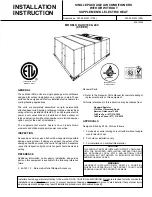
ECM Overview and Setup
UNT-SVX07E-EN
97
Heating
In general, the (CSTI) changeover function will provide
heating if:
1.
A unit is factory-configured with a changeover coil
(cooling/heating) as the only coil or as the main coil
portion.
2. SW3 on the CSTI adapter board is turned on, and the
parameter set to
or
to use the
changeover functions.
a.
parameter should be chosen if the unit has a
changeover coil without electric heat.
b.
parameter should be chosen if the unit has a
changeover coil with electric heat. Generally, this
will perform the same as the
parameter but
will in addition, disable the heating function on
electric heat and on the changeover coil heat if there
are fan failures. The auxiliary heating coil valve will
continue to respond to customer heating requests.
3. The motor control board has sensed that there is hot
water available on the supply/bypass line for the
changeover coil. In this case, “hot” water is
determined if:
a. A 10K NTC thermistor (similar to Trane part number
X13790374010) is wired properly to the motor
control board, through the crossover cables and
CSTI adapter boards.
b. The input impedance of the thermistor circuit must
be set correctly (the
parameter should be set
to
for CSTI units).
c. The temperature sensed is higher than the
parameter.
d. The
parameter is higher than the
parameter.
e. The temperature is not in the dead-band between
the
parameter and the
parameter (in
this case, previous state will be retained).
4. The customer thermostat is properly hooked up the
input strip 1TB3, and is requesting heating input (V2)
based on the customer heating set point being higher
than the space temperature.
5. The heating input on 1TB3 will drive the main
changeover coil IF conditions 1–4 are satisfied, but will
always drive the auxiliary coil valve (if present).
Electric heat will be locked out (where present) if hot
water is available since SW4 will be factory set to “ON”
in these units.
SW4 selects the electric heat lockout function, where we
will lock out the electric heat circuit based on either:
1.
The presence of hot water in the changeover coil
section (if the
parameter is set to
).
2. Abnormal behavior of the fan/s (if the
parameter
is set to
).
3. Or a combination of both the presence of hot water or
abnormal behavior of the fan/s (if the
parameter
is set to
).
4. The preceding three examples depend on the
inference of the motor control board that hot water is
present. In this case, “hot” water is determined if:
a. The temperature sensed is higher than the
parameter.
b. The
parameter is higher than the
parameter.
c. The temperature is not in the dead-band between
the
parameter and the
parameter (in
this case, previous state will be retained).
d. The input impedance of the thermistor circuit must
be set correctly (the
parameter should be set
to
for CSTI units).
VelociTach Control Board
Configuration
Every Trane unit with ECM motors will have modules
specifically configured at the factory for the operation of
that unit. The motor control board configuration label is
affixed to the low-voltage access lid on the outside of the
control panel (see
Figure 77, p. 88
and
Figure 89, p. 98
).
The VelociTach motor control board label may be on the
back-side of the low voltage access lid, depending on the
unit configuration.
The serial number of each unit and the custom
configuration settings specific to that unit will be printed
on the label for convenient matching of labels/settings to
specific units. Programming a unit with the settings from
another unit will result in abnormal operation. The label
contains four important sections:
1.
How to enter the configuration menu
2. The description and meaning of the Error Codes
3. The description and meaning of the status display
4. The parameter names and values specific to that unit
















































